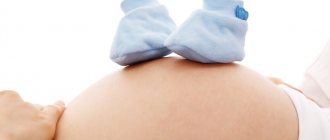Pregnancy is a period that lasts from the moment of conception of a child until its birth. On average, it lasts about 40 weeks or 10 obstetric months. According to clinical standards, the start date of pregnancy is usually set by the first day of the last menstrual period, so the gestation period is about 38-39 weeks.
Childbirth is considered normal if delivery occurs at 38-42 weeks. With the help of a mass of laboratory tests and instrumental studies, specialists can calculate the approximate date of birth, but these assumptions are not always quite accurate. An expectant mother who already has children can guess about the approaching birth by carefully observing her body.
Precursors of labor in multiparous women are a set of symptoms that appear in a woman who is about to give birth again a few days before the birth of the child.
Difference between signs in primiparous and multiparous
The anatomical structure of the uterus of a woman who has previously been in labor differs in a pregnant woman for the first time. The fact is that when passing through the birth canal, the fetal head exerts high pressure on the cervix, promoting its stretching. Due to this, it becomes more elastic, pliable and wider. Therefore, the first stage of labor in women who give birth again proceeds more quickly and less painfully. As a rule, it lasts from 3 to 7 hours, and for a primigravida it lasts from 6 to 12 hours.
Due to the fact that the body is better prepared for the process, signs of labor in multiparous women appear a little later, about a week before delivery. Also, their clinical picture may be more pronounced. In women pregnant for the first time, these manifestations are observed much earlier - approximately 15-20 days before the birth of the child.
For some mothers who give birth again, signs preceding the birth of a child may appear a day before it. Therefore, multiparous women need to carefully monitor their body from 34-35 weeks. The preparedness of the birth canal can affect the speed of the first period of delivery, so you should not delay your trip to the maternity hospital.
It is important to know that when contractions that are characterized by cyclicity appear, a woman giving birth again should go to the maternity hospital, since the first period of delivery may not always be accompanied by the development of pain or other manifestations.
If more than 8-10 years have passed between the birth of the last child and the new pregnancy, then the harbingers of labor in multiparous women may appear 12-14 days before delivery. This is due to the fact that over such a long period the woman’s body is completely restored, and the birth canal loses its elasticity.
Also, a woman should not be guided by how her previous pregnancy proceeded, since the influence of many factors (size of the fetus, height of the uterine fundus, the presence of concomitant diseases, etc.) can affect childbirth. Therefore, the appearance of signs can be observed at an earlier or later period, in comparison with the first birth.
If the first birth was carried out using a cesarean section, then the warning signs will appear in the same way as in women giving birth to a child for the first time. This is because the cervix did not stretch as the baby did not pass through the birth canal.
Specialists
Kuznetsova Tatyana Vladimirovna
Obstetrician-gynecologist with 35 years of experience, chief physician of the center.
Tatyana Vladimirovna’s specialty is the diagnosis and treatment of infertility. Performs surgical interventions and pregnancy monitoring. Recipient of the state award "Order of Honor".
Makatsaria Alexander Davidovich
Obstetrician-gynecologist, famous scientist, founder of clinical hemostasiology.
It will help you plan and maintain your pregnancy if you have had cases of fetal loss, thrombosis, obstetric complications or blood coagulation disorders. You can also contact your doctor for a transcript of hemostasis tests.
Egorova Elena Borisovna
Obstetrician-gynecologist of the highest qualification category.
Specializes in peritoneal factor of infertility in women and management of problematic pregnancies.
It will provide effective help if, before conception, you were diagnosed with adhesions, endometriosis, erosion or other pathologies of the cervix.
Akinshina Svetlana Vladimirovna
Obstetrician-gynecologist, hemostasiologist with an academic degree.
Pregnancy management S.V. Akinshina will help avoid severe complications: gestosis, placental insufficiency, fetal loss syndrome.
The doctor's expertise includes hemostasis disorders and immunological infertility.
Bitsadze Victoria Omarovna
Gynecologist-hemostasiologist, professor, doctor of medical sciences.
The doctor's profile is management of high-risk pregnancies, including in women with genetic thrombophilia and a tendency to spontaneous bleeding. Develops effective treatment regimens for infertility associated with autoimmune pathologies and hemostasis disorders.
How do the warning signs of labor appear?
It is worth taking into account that some of the symptoms described below may not appear in a single clinical case. This is not a deviation, it’s just that each woman’s body is unique and can adapt differently to future childbirth.
Prolapse of the uterine fundus. A few days before birth, the fetus is pressed by the presenting part (which is most often the head) to the lower part of the uterus, lowering it lower so that it is closer to the entrance to the pelvis. The fetus tries to take the most comfortable position so that at the time of contractions its movement along the birth canal is as fast and efficient as possible.
As a result of these changes, the uterine fundus descends, due to which this part of the muscular organ no longer puts pressure on the internal organs, diaphragm, abdominal aorta, etc. Women note the disappearance of shortness of breath, heaviness in the stomach after eating, belching and a burning sensation disappear.
However, such a change in the position of the fetus and uterus may be accompanied by an increase in pressure on the organs located in the pelvis. For example, increased pressure on the bladder will lead to increased diuresis, and the posterior wall of the uterus is located close to the ampulla of the rectum, so when the position of the fetus changes, the number of bowel movements may also increase.
Prolapse of the uterine fundus can be determined if the following changes are present:
- the shape of the abdomen changes, it becomes similar not to a ball, but to a pear;
- the woman notices ease of breathing, tension in the chest and heartburn disappear;
- the urge to urinate increases;
- due to the redistribution of weight, posture changes slightly, resulting in a specific “duck” gait;
- A palm can easily fit between the chest and stomach.
Abdominal prolapse is one of the main precursors of labor in multiparous women. In primiparous women, this change appears 10-14 days before delivery, and in women giving birth not for the first time - much later (maybe even a day before delivery).
Loss of body weight. Shortly before delivery, the expectant mother may notice a slight decrease in body weight. This is associated with increased diuresis and a possible increase in stool frequency. Therefore, if a woman in labor has a large amount of excess fluid in her body, then physiological losses before childbirth can amount to up to 2-3 kilograms.
The main reason for weight loss is a decrease in progesterone concentration. This is the main hormone responsible for maintaining the pregnancy process from conception to delivery. However, towards the end of pregnancy, its concentration in the blood decreases, and at the same time the concentration of estrogen increases. It is these biologically active substances that help remove excess fluid from the body. A reduction in swelling is immediately noticeable in the wrists, hands, feet and legs.
Removal of the mucus plug. During pregnancy, a special secretion is released from the lumen of the cervical canal. Externally, it looks like a thick, sticky and slightly jelly-like mass that forms a plug. It completely fills the entire volume of the cervical canal, due to which bacterial flora cannot penetrate from the vagina into the uterine cavity. This allows the cervical mucus, or mucus plug, located in the cervix to protect the fetus from the possible development of an ascending infection.
Before the first stage of labor begins, the cervix begins to soften due to an increase in estrogen concentrations. This leads to a slight opening of the cervix and the release of cervical mucus out. A pregnant woman may notice discharge on her underwear in the form of yellowish-brown mucus, transparent and jelly-like in consistency, it has no odor.
The mucus plug can be released all at once, or it will be released in parts throughout the day. In the second case, there may be a feeling of slight discomfort associated with “sipping” in the lower abdomen. However, most often the release of a mucus plug is not accompanied by any noticeable changes in the woman’s condition. After cervical mucus is discharged, the expectant mother is not recommended to visit a pool, bath or open body of water, as when immersed in water, it will penetrate into the vagina. This significantly increases the risk of infection of the amniotic sac of the fetus.
The appearance of training contractions. False contractions are usually called those contractions that appear immediately before labor, but do not contribute to the dilation of the cervix or the advancement of the fetus along the birth canal. A contraction is a single contraction of the walls of the uterus, which usually lasts a few seconds. At the moment of spasm, the woman notices increasing, and then decreasing, tension in the lumbar region and lower abdomen. If you put your palm on your stomach during a contraction, you can feel that it becomes very hard, and after it is over, it relaxes and becomes soft. Apart from arbitrary short-term spasms, false contractions are not characterized by anything else.
It is quite simple to differentiate between training and real contractions. Often, false uterine spasms are quite weak, irregular, do not cause much discomfort and occur no more often than once every half hour. True contractions are characterized by cyclicality and increasing intensity. Their result is dilatation of the cervix. If there is any doubt about the type of cramping, a simple obstetric examination will suffice to detect visible dilatation.
Training contractions are not an indication for going to the maternity hospital. They can repeat for several hours and then stop. Most women note that they most often occur in the morning and evening hours for several days.
Rush of amniotic fluid. The rupture of amniotic fluid involves the release of a large amount of clear fluid from the vagina. If the integrity of the amniotic bladder is partially disrupted, it can be released in portions. During the rupture of amniotic fluid, the woman does not feel any discomfort. However, if the structure of the amniotic membrane is disturbed, infection of the fetus or aspiration is possible.
In women who give birth repeatedly, the amniotic sac often bursts spontaneously, and contractions begin a few hours later. Sometimes the amniotic membrane does not rupture, so it is opened directly in the maternity hospital.
If the amniotic pods have passed on their own, then the woman needs to immediately go to the maternity ward. In a situation where there is a slight leakage of fluid, the pregnant woman should seek medical help. Diagnostics will help confirm or refute the presence of a defect in the amniotic sac.
Changes in fetal behavior. Most women note that approximately 7-10 days before the birth of the child, its activity decreases. This change is one of the most common. The fact is that changes in the behavior of the fetus are associated with a decrease in space inside the uterus - it simply has nowhere else to move.
If the activity of the fetus has increased, then you should consult a doctor as soon as possible. Such changes may indicate the development of intrauterine hypoxia associated with oxygen starvation. A complete cessation of movement may indicate increased fetal discomfort. In both situations, it is worth seeking medical help to perform cardiotocography.
Strengthening the nesting instinct. The desire to clean up and rearrange furniture from one place to another, increased anxiety - all this may indicate that labor is approaching. These changes in behavior are caused by changes in the functioning of the central nervous system, which slightly distort the mental state of the expectant mother. Other signs of impending labor may not yet appear, but the woman’s psyche begins to gradually prepare for future childbirth.
Changes in the stool. Changes in the consistency of stool and increased frequency of bowel movements on the eve of delivery are associated with an increase in estrogen levels and the removal of excess fluid from the body of the expectant mother. Similar changes are observed in all women during menstruation. The frequency of bowel movements may increase up to 2-3 times a day, and in parallel with this, a liquefaction of physiological waste may be observed.
However, we should not forget that increased frequency of bowel movements, development of diarrhea and nausea may indicate the development of foodborne toxic infection. Therefore, if a woman’s condition worsens, it is better to seek medical help.
Changes in urination. Hormones, the production of which increases significantly during the last trimester, affect not only the functioning of the digestive tract, but also the functioning of the urinary system. Changes associated with diuresis may be a signal that labor will begin soon. Multiparous women may experience urinary retention or excessive discharge 2-3 days before delivery.
How to detect warning signs during repeated births?
A woman who gives birth again needs to know that all subsequent births can be much faster, and the period between the precursors and delivery will be significantly shortened. If in primiparous women changes in well-being can be noticeable within 2-3 weeks, then in multiparous women they can appear within a day.
If you notice changes in your health that are similar to the harbingers described above, then it is better to prepare for the fact that you will soon have to go to the maternity hospital. According to statistics, in multiparous women, the period of pushing can proceed rapidly, so you should get to the maternity hospital as quickly as possible.
You should not make assumptions about the upcoming birth based on past experience, since each birth of a child will proceed in a new way, regardless of how many there were before it. If you remember your first experience with anxiety, then you can be reassured by statistics that confirm that the second and subsequent births, as a rule, are easier and faster.
Women who last gave birth more than 10 years ago should be prepared for the fact that the birth canal has lost its elasticity, so their labor will proceed like the first, and warning signs will appear long before the first contractions.
Each woman begins the process of giving birth differently. For example, some people experience a classic picture - a gradual increase in the intensity of contractions and a reduction in the intervals between them. Others may experience rapid labor - contractions are very active at once, and the intervals between them are short. For others, the preliminary period may be prolonged. Despite significant differences, almost every woman experiences signs of labor in multiparous women. Only the number of symptoms, their intensity and the period of occurrence can differ.
Interesting Facts
| Options | Indications |
| Time from conception | 37 weeks |
| Period by month | 39 weeks |
| What month | 9 |
| Dimensions and weight of the fetus | 507 mm, 3230 g |
| Uterus dimensions | VDM - 36-38 cm |
| Pregnant weight | Gain from the beginning of pregnancy is 10-15 kg; over the last week 200-300 g |
Your baby is the size of
Watermelon
507 mm Size
3230 g Weight
Surely now you are impatient and counting the days, and maybe even thinking about how to give birth faster at 39 weeks of pregnancy. But don’t rush time; the baby normally has at least a couple more weeks to finally prepare for birth. It is too early to talk about additional medical stimulation, only if there are indications for it. Let's find out what happens to the fetus and mother at 39 weeks of gestation.
Has it really started?
The long wait is about to end and the mother will be able to put her baby to her breast. She feels happy and excited as she approaches the long-awaited end of her pregnancy. But how do you understand that labor has begun and is it possible to relieve the pain?
Of course, each organism is individual. Some pregnant women experience slight anxiety the day before contractions begin, and mild tachycardia, headache or fever may occur. Diarrhea or increased blood pressure may also develop. The expectant mother can ask her doctor all her questions, and he will help relieve her anxiety.
The stomach drops
Not only the mother, but also the child is preparing for childbirth. A week or two before birth, the fetus takes on a prenatal position: it turns its head down and enters the pelvic space. Outwardly, this is reflected in the position of the abdomen: if previously it was almost up to the pregnant woman’s nose, now it goes down as far as possible. A woman may feel sharp pain in the pubic area when walking. This is how the baby’s head presses on the bones of her pelvis.
Before giving birth, heartburn and shortness of breath caused by compression of the diaphragm recede, the expectant mother may lose a little weight - swelling will go away.
Sudden onset of labor
In some situations, the precursors of labor may not appear in multiparous women, so labor may immediately manifest itself as contractions. Contractions are muscle contractions of the uterus, which contribute to the gradual expansion and shortening of the cervix, moving the baby along the birth canal. They manifest themselves in the form of periodic nagging pain localized in the lower abdomen and lower back. Over time, these sensations become more intense and regular. If contractions begin to appear cyclically, then this is a reason for a trip to the maternity hospital. It is best not to delay seeking medical help; the expectant mother should immediately call an ambulance and report changes in well-being so that the team is informed about the beginning of the first stage of labor.
There are several main signs that indicate the onset of contractions:
- During training contractions, a woman notices pulling sensations in the lower abdomen, but before the start of the first stage of labor they become more intense and painful. Many mothers claim that true contractions are somewhat similar to very severe pain during menstruation.
- If you don’t know how to determine if contractions are false or true, then you should try breathing exercises: take a slow and deep breath, then hold your breath for 2-3 seconds and exhale slowly. Training contractions, as a rule, go away after these exercises, but if the contractions are true, then the intensity of the pain will not decrease.
- Regularity, a gradual increase in the frequency of contractions and the duration of contractions are the main signs by which it is worth assessing the body’s readiness for childbirth. A woman can take a notepad and pen and record the duration of the spasm and the duration of the relaxation period. Using this method will help ensure that you understand that true contractions have begun, and the doctor will receive information about the dynamics of labor.
When is it time to go to the maternity hospital?
Sometimes labor may be premature and contractions will appear earlier than the expectant mother expects. Therefore, by the 7-8th month of pregnancy, it is worth collecting all the things that will be useful in the maternity ward and preparing a first aid kit for the baby.
Uterine bleeding is the most dangerous complication, which indicates the premature onset of labor and possible placental abruption. Often, a woman may complain of cramping pain in the lower abdomen and a sharp deterioration in well-being, manifested by weakness and dizziness. If there is bloody discharge from the vagina, you must immediately transport it to the maternity hospital.
The rupture of amniotic fluid is the second most important sign, which indicates that it is time for a woman to go to the maternity hospital. As a rule, after rupture, a gradual opening of the cervix and further delivery begins. However, in some situations, even after the amniotic fluid has broken, labor does not begin. This condition is especially dangerous for the fetus, since prolonging the anhydrous period will worsen its condition.
Another important sign is the transition of training contractions into real ones. In a multiparous woman, dilatation of the cervix may not be accompanied by intense pain. The peculiarity of such a latent course of the first stage of labor is that it proceeds extremely rapidly. After the cervix is fully opened, the baby begins to move through the birth canal, so the woman may simply not have time left to arrive at the hospital on time.
Fetal development
At week 39, the child’s weight is 3.2 kg, height is 50.7 cm. The exact figures depend on heredity, the sex of the fetus and the number of pregnancies: the second and subsequent children are much larger than the first, and boys are usually larger than girls.
Despite the fact that the baby receives all the nutrients and oxygen through the placenta, his digestive system is already developed, and the original feces - meconium - has formed in the intestines, which is expelled in the first few days of the baby's life. Don't be intimidated by its appearance; normally it is almost black and oily.
The child is highly dependent on the psycho-emotional state of the mother: he experiences all the same feelings as you. Hormones of stress or pleasure enter his blood, and his movements will be more active during your experiences. Therefore, we wish you peace of mind and more positive emotions.
What to take with you to the maternity hospital?
Every woman should make sure that by the second half of the second trimester she has a bag ready for a trip to the maternity hospital. It should contain documents (passport, exchange card, insurance, birth contract, if any) and essential things that will be useful during childbirth and while staying with the baby in the hospital.
The mother in labor must take with her:
- a nightgown and robe, in which she will be in the maternity hospital after the birth of the child (it is better to give preference to natural fabrics);
- several pairs of socks and slippers;
- postpartum pads and disposable diapers;
- hygiene items: soap, towel, toothbrush and toothpaste, comb;
- a couple of bottles of water and cookies for a snack.
It is worth making sure in advance that all things are collected for a comfortable stay for the baby in the maternity hospital with his mother. Place in your bag a couple of warm rompers, overalls and vests, bonnets, several flannel and cotton diapers, a warm blanket with a duvet cover and socks.








